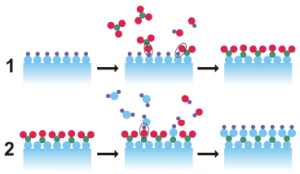Microencapsulation by ALD/MLD in Fluidized beds
In many kinds of solid particulate products, degradation or incompatibility with other constituents of the product mixture are regular issues. Think of oxidation (due to contact with air) or undesired reactions taking place with other substances. Therefore, these materials need to be protected from their environment so they function optimally at the time of use. Coating the particles in question with an impervious layer can help improve the lifetime or functionality of these materials, or even facilitate the use of otherwise impossible combinations of materials.
Adding a coating layer to a product does, however, add an extra component to the product. Therefore it is desired to keep this layer as thin as possible. Using Atomic Layer Deposition (ALD) or Molecular Layer Deposition (MLD), single atomic or molecular layers are applied to the core particle (Fig. 1). Recently this technique is being applied in fluidized beds. Advantages of using fluidized beds for this technique over the conventional liquid phase synthesis are that there is better control of the layer thickness and other product properties and that scale-up and down-stream processing are easier. Depending on the number of layers applied, which then relates to the number of cycles, the coating thickness ranges from a single molecular layer to typically about 10 nm (see Fig. 2). The challenges involved with ALD and MLD processes in fluidized beds are to find – given a certain core particle – the optimal shell material as well as the optimal process parameters necessary to achieve a good end product.
The objective of this project is to perform ALD or MLD in a fluidized bed using various types of substrates. A thin, but impenetrable layer must be created around these substrates. Tests will be performed on how effective the protective layer is. What tests these are, will depend on the materials in question. Points of focus are the materials involved and possible pretreatment, control of the layer thickness and smoothness, optimization of the fluidized bed parameters, etc.
MSc. Project at P&E and ChemE

Chair:
Intensified Reaction & Separation Systems
Involved People:
Andrzej Stankiewicz
Joop H. ter Horst
Marloes A. Reus
Facilities used: